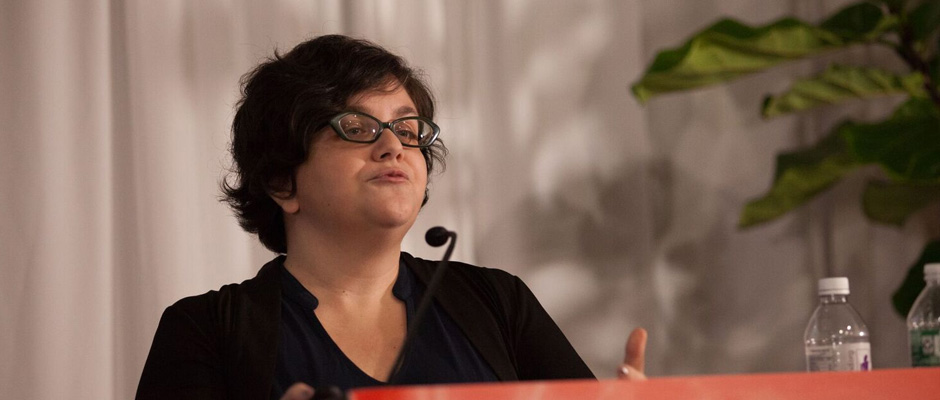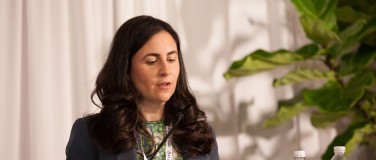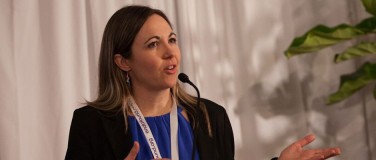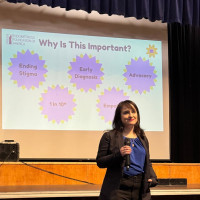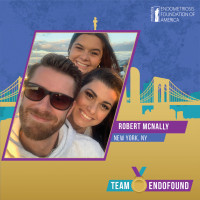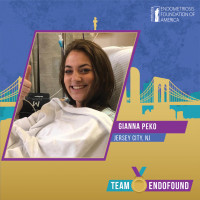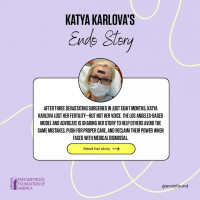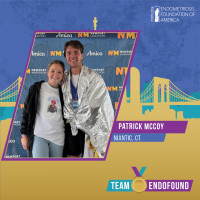PATIENT AWARENESS DAY 2018:
LIVING YOUR BEST LIFE WITH ENDO
Sunday, March 18, 2018, (8am-5pm) Einhorn Auditorium (131 E76th st) at Lenox Hill Hospital, NYC
The Citizen Endo Project: Phendo Update
Noemie Elhadad, Ph.D.
- Hi everyone, I'm a Associate Professor of Biomedical Informatics and Computer Science at Columbia University and I'm gonna be talking about- oh look, it's working by itself. Citizen Endo. Let me start by telling you what you probably all know in this room which is that there is a disconnect between the patient experience and the clinical description of endometriosis. We just had a very interesting discussion in the room in the previous session. On one side there's patients who are experiencing symptoms and on the other side there are clinicians who are missing the symptoms. In the best cases, some of the symptoms are ignored. In the worst cases they are normalized even stigmatized and that's an issue. That's an issue for care, obviously there is lack to diagnosis, there's a whole lot of misdiagnosis that happen. It's also an issue for research and it's a vicious circle, right? As long as we don't know how to characterize a disease, we can't really research it correctly, we can't have good ways of stratifying the disease. I'm a data scientist, I work at the intersection of medicine and technology and our idea is how can we bridge this gap between the ways patients experience a disease and the way researchers and clinicians are characterizing the disease. And we built this project called Citizen Endo because we're trying to take this approach that comes from Citizen Science, where patients are acting as citizens and providing information, acting themselves as researchers where they each belong to a large community and they each provide a little bit of what they know about the disease and together we can slowly but surely paint this map of endometriosis. And data science comes in because if we're large enough cohort of patients describing the disease together in all of our variety and diversity, we can use big data techniques and artificial intelligence techniques to then understand and get new insights. It's a very different way of doing research, it's not the traditional type of clinical trials that there are around right now, but I think it's one way that we can try to think out of the box about endometriosis. We started this research about two years ago. The way we did it is we thought that if we start from scratch, one way to collect the data and to get a lot of insight about endometriosis is to actually build an app and actually two years ago I had come here and give a little bit of data about where we were, we had just made a series of focus groups with patients and we since then did a lot of participatory design activities where we build the app. So why did we decide to do an app? We didn't want to do a set of questionnaires that are static. As you know, endometriosis is kind of like changes throughout a cycle and even if you don't have a cycle, they're ups and down in symptoms and that's interesting, right? We want to capture how it changes through time because that tells us something about the mechanisms of the disease. And having questionnaires that ask, "What was it like three weeks ago? What was it like in the past three months?" there might be some weird biases of recall. And so through an app if you ask and you track your experience day to day or even moment by moment you can actually have a better recall of your experience of the disease. We ended up with, it's not working anymore, oh no it worked too much, sorry. Okay, so we built this app called Phendo and it's available now for every type of smartphone which we're very happy to say. And Phendo is a research app so through your app you can join the study, it's a research study, it's approved by the IRB at Columbia University. There's a consent. The data that you collect is private and secure, it's HIPAA certified and it's on volunteer basis. It's everything that you would do through a regular study. You can opt out of the study and opt in again if you wanted to. And as you opt in into the study you can decide- we ask you to track as much as you want and for a minimum of three months but it's up to you how much you want to do it. And so very quickly, what does it look like. In the profile, we have a link to your medical history and that's an essential part of the study. This is a link to the WERF questionnaire. WERF is a World Endometriosis Research Foundation questionnaire which is a gold standard questionnaire, it's more of an AP appendiology cold type of questionnaire but it's a very important one for us. It asks about age at menarche, when did you start having your period, your surgical history, your hormonal and treatment history. And then comes the more day to day tracking. So we ask you about things like how was your pain at different moments of your day, any GI or urinary issues, how's your mood, are you bleeding right now, are you taking any medication, etc. etc. And all of these questions came from all of these participatory design activities that we've done with patients. We really tried to have this app be checking as much as possible to the needs of endometriosis patients. As part of the app as much we also try to ask a lot of functional assessment of the patients. The little square images over there are kind of asking what type of activities were hard to do today. And then there's a whole set of screens in the app that are about you reviewing your own data. So we have a calendar, you have a way to review your last 30 days and more recently we rolled out a functionality for you to even, if you wanted, print out your most recent tracking for you to print out and discuss with your clinician if you wanted to. That's something that some of our users have asked. So, I'm gonna show you a few of the things that we've learned with the app so far and obviously this type of studies, it's long term study. We're trying to here build this really large data set of patient experiences again with our goal of learning at scale from patients and learning from these many many experiences and many day to day experiences of patients. Our ultimate goal is to have about 10,000 participants. We launched in December 2016 and we have 3,500 so far. To be very honest with you, we were tremendously happy with the response of patients. And I think it's a testament to the enthusiasm of the endo community. It's also a testament to, and a thank you and a gratitude to EndoFound who helped us in recruiting patients in the first place, so thanks again. There's something that also makes us really happy that is not only are we having participants, we have participants that actually using the app the way we want them to which is they are actually day to day telling us what's going on with their body. So we have moments by moments that they track and day to day information that they give us. So we have about 70 countries that are being represented in our participants today and it's interesting to look at this because there are very wide variations in the type of medications, in the type of self management. The data set is already so interesting and there is so much to study already and we can't wait to see what's gonna happen when we reach our target enrollment. What I'm going to do now is I'm going to show you a few just hints about the type of thing that we can already gather from here and tell you a bit of the next steps. Yes, okay. So first one is when we look overall, so these are women who have had a laparoscopic surgery and have had a confirmed diagnosis of endometriosis and who have tracked moderate or severe pain and these are the percentage of participant who report moderate or severe pain in one of these locations. To us this is interesting, this is not an analysis in time or within their cycle or about time, it's more of a snapshot information but this is already interesting to us. This is, obviously you guys know this, endometriosis pain is not only pelvic pain. Back pain, lower back pain is the second most common type of pain in here. GI, sorry this is going too fast. GI and urinary symptoms, Endo Belly is the most common one. Nausea is the next one, gas and diarrhea, painful bowel movement. Urinary issues are way more frequent than we have found in the literature. As far as other symptoms, which is kind of like this miscellaneous bag of symptoms that patients are reporting, mentally foggy, dizziness, hot flash and our usual chronic disease fatigue is the most frequent type of symptom reported. Still not, yes, okay. This another interesting overall statistics about our community of participants so far. So these are we're asking our participants to tell us, this is kind of a customized field, tell us what type of food or exercises you think are helping you or hurting you. And turns out that there's the usual culprits like gluten and dairy and caffeine and alcohol that people are trying to monitor as trigger for pain, but when it comes to exercise, it's not always clear what hurts and what helps. And for some participants, for example, running and walking is beneficial and for others it's actually not beneficial at all so that's another interesting thing that we're seeing just by looking at this descriptive statistic. We're not yet doing any smart math or anything on our population here. I think Dr. Setchkin was asking about opioids. We're seeing a very very large population here, throughout the world actually, not only we tried in the US and other, but in the US in particular very large proportion of our patients are on opioid medication. I give you this very very quick description of our data set and really that's interesting, but that's not our goal. Our goal is to understand how are all these variables relating to each other? And how are these variables changing through time for a person? We want to understand what are the clusters of participants and how does that inform us as to what are the subtypes of endometriosis. We know that there's phenotypes of endometriosis like dipin filtrated, endometrial mass superficial, we know there's these stages. How does that compare, how does that correlate with the way patients experience a disease, that's what we want to get at. There's three ways in which we're going at it, one is we're expanding Phendo into other languages, and it takes time, but that's one way for us to recruit more participants and to get more diversity in the type of participants. The other is we're using new type of methods that allow us to deal with the amount of participants and the amount of data that we are collecting. This is so far the largest amount of data we've ever seen being collected about endometriosis. And the last way in which we are thinking about this new type of analysis is we're partnering with different startups. So one is Clue, the Menstrual Tracker. The reason we are partnering with them is we want to make sure that what we discover about our participant is really about endometriosis and not about a healthy menstrual cycle. Clue has millions of women tracking their menstrual cycle, most of them thankfully are not sick, so we want to be able to confirm our finding. With uBiome, we're partnering with them because we're interested in all of those GI symptoms and so for all of you Citizen Endo participant, you might receive in your email a consent modification for a kit to get your micro biome tested. So stay tuned. So I want to thank EndoFound obviously I want to thank the National Library of Medicine and their training grant and I want to thank all the participants who really are making this project so rewarding. If you have any question, ideas, these are the people who are really making the project happen, current and past members of the project. We're all over social media. Medium is really where we put up our findings and papers published so if you're really interested in everything that I've talked about, go and read about-



